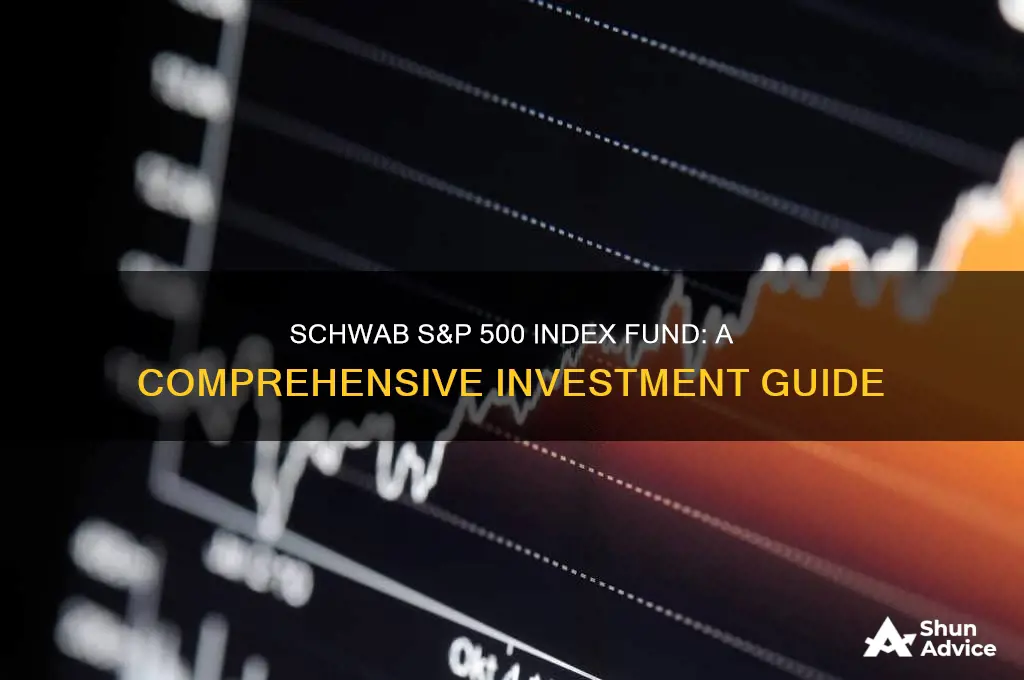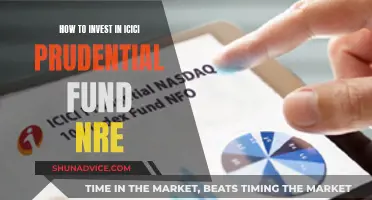
The Schwab S&P 500 Index Fund is an investment fund that tracks the Standard & Poor's 500 index, a widely recognised benchmark for US stocks. The fund offers investors exposure to a diverse range of leading US companies, aiming to mirror the performance of the S&P 500. With an ultralow expense ratio of 0.02-0.03%, the fund provides a cost-effective way to invest in a core large-cap holding. As of November 27, 2023, the fund held assets totalling $73.90 billion across 504 different holdings, including well-known companies such as Apple, Microsoft, and Exxon Mobil. The fund has delivered solid returns over the years, making it a popular choice for investors seeking long-term growth opportunities.
| Characteristics | Values |
|---|---|
| Type | Mutual Fund |
| Symbol | SWPPX |
| Total Expense Ratio | 0.02% |
| Fund Goal | Track the total return of the S&P 500® Index |
| Investment Minimum | None |
| Holdings | 504 as of 27 November 2023 |
| Assets | $73.90 billion as of 27 November 2023 |
| Largest Holdings | Apple Inc., Microsoft Corp., Exxon Mobil Corp., Johnson & Johnson, JPMorgan Chase & Co. |
| Fund Managers | Agnes Hong, Ferian Juwono, David Rios |
| Trailing 12-Month Return | 10.11% |
| Trailing 3-Year Return | 10.33% |
| Trailing 5-Year Return | 10.99% |
| Trailing 10-Year Return | 11.12% |
| Inception Date | 19 May 1997 |
What You'll Learn

The fund's goal is to track the total return of the S&P 500® Index
The goal of the Schwab S&P 500 Index Fund is to track the total return of the S&P 500® Index. The fund aims to provide investors with a straightforward and low-cost way to gain exposure to the performance of the S&P 500 Index.
The S&P 500 Index is a market-capitalization-weighted index of 500 leading publicly traded companies in the U.S. It is considered one of the best gauges of large U.S. stocks and the overall equities market due to its depth and diversity. The index includes companies from various sectors, such as technology, software, banking, and manufacturing, and is widely used as a benchmark for the U.S. stock market.
The Schwab S&P 500 Index Fund seeks to replicate the performance of the S&P 500 Index by investing in the stocks that comprise the index. The fund generally invests at least 80% of its net assets in the stocks included in the S&P 500 Index, giving each stock the same weight as the index. This means that the fund's performance should closely track the performance of the index, providing investors with a way to gain diversified exposure to the largest and most liquid U.S. companies.
The fund has a low expense ratio of 0.02% to 0.03%, which is considered ultralow for an S&P 500 fund. This low expense ratio means that more of the investor's money is going towards the investment itself, rather than fees. The fund also has no investment minimum, making it accessible to a wide range of investors.
Overall, the goal of the Schwab S&P 500 Index Fund is to provide investors with a simple and low-cost way to track the performance of the S&P 500 Index, one of the most widely watched benchmarks for U.S. stocks. By investing in this fund, investors can gain diversified exposure to a broad range of leading U.S. companies.
Vanguard Index Funds: Best Investment Options for 2023
You may want to see also

The fund has a low expense ratio of 0.02%
The Schwab S&P 500 Index Fund has an ultralow expense ratio of 0.02%. This is an important feature of the fund, as the expense ratio is a key metric for investors when assessing the suitability of a fund. The expense ratio is the annual cost of owning a mutual fund or ETF, and it is usually expressed as a percentage of your investment in the fund. For example, a fund with a 0.30% expense ratio will cost you $30 per year for every $10,000 invested.
The expense ratio is an important consideration because it directly impacts your investment returns. The higher the expense ratio, the more it will eat into your returns over time. This is especially true when you consider the power of compounding. As your portfolio balance grows, a higher expense ratio will charge you a larger amount each year, reducing your overall returns.
The Schwab S&P 500 Index Fund's expense ratio is significantly lower than the category average of 0.85% and 0.5%. This low expense ratio is a major advantage of the fund, as it means investors will retain more of their returns.
When assessing the expense ratio of a fund, it is important to compare it to the simple average of all funds, as well as the asset-weighted average of all funds. This will give you a sense of how competitive the expense ratio is relative to other funds on the market.
In addition to the expense ratio, investors should also be mindful of other fees associated with funds, such as sales loads, which can be very costly. It is also worth noting that the expense ratio of a fund is usually stable and tends to remain the same from year to year, even if there is a downward trend over the long term.
The low expense ratio of the Schwab S&P 500 Index Fund is, therefore, a significant advantage for investors, as it will result in lower costs and higher returns over time.
Strategies for Investing in DFA Funds Solo
You may want to see also

The fund is a core large-cap holding in a portfolio
The Schwab S&P 500 Index Fund is a core large-cap holding in a portfolio. It is a straightforward, low-cost fund with no investment minimum that offers simple access to 500 leading U.S. companies. The fund's goal is to track the total return of the S&P 500 Index, which is one of the most widely watched benchmarks for U.S. stocks. The fund covers about 80% of the investable market capitalization of the U.S. equity market.
Large-cap stocks, or those with market capitalizations of $10 billion or more, are generally considered safer investments than mid-cap or small-cap stocks. Large-cap companies are typically well-established, dominant players in their respective industries, and they tend to have transparent operations, making it easy for investors to find and analyze information about them. They are also often dividend payers, as their mature and stable market position allows them to establish and commit to high dividend payout ratios.
Large-cap stocks are typically blue-chip companies at peak business cycle phases, generating established and stable revenue and earnings. They tend to move with the broader market economy because of their size and leadership position. These companies also have a global market presence and produce innovative solutions, so news about them can have a significant impact on the overall market.
Large-cap stocks are generally less volatile than small-cap stocks, particularly during rough market conditions. They are considered a more conservative investment choice and are often used as core portfolio holdings due to their stability and dividends. Financial advisors usually recommend diversifying an investment portfolio by including a mix of large-cap, mid-cap, and small-cap stocks to balance risk and return prospects.
A Beginner's Guide to Index Funds via Wells Fargo
You may want to see also

The fund has a strong record dating back to 1997
The Schwab S&P 500 Index Fund has a strong record dating back to its launch in May 1997. The fund's goal is to track the total return of the S&P 500 Index, one of the most widely watched benchmarks for U.S. stocks. Over the years, the fund has closely tracked the index, with the only difference in returns being the fund's expense ratio.
As of November 27, 2023, the fund had assets totaling almost $73.90 billion invested in 504 different holdings. The fund's largest holdings include well-known companies such as Apple Inc., Microsoft Corp., Exxon Mobil Corp., Johnson & Johnson, and JPMorgan Chase & Co.
The fund has consistently delivered strong returns. As of December 2016, the fund had returned 10.11% over the past year, 10.33% over the past three years, 10.99% over the past five years, and 11.12% over the past decade. The fund's performance has been rated by Morningstar, placing it in the 35th percentile of large-blend funds for the trailing 12 months, the eighth percentile for the trailing three years, the 13th percentile for the trailing five years, and the 20th percentile for the trailing 10 years as of late March 2017.
The fund's risk has been assessed as average for the trailing three-year period and below average for the trailing five and 10 years by Morningstar. The fund's expense ratio is an ultralow 0.02% to 0.03%, making it one of the lowest available for an S&P 500 fund.
College Fund Investment: Strategies for Financial Security
You may want to see also

The fund is sponsored by Charles Schwab, a respected name in the industry
Charles Schwab has consistently been rated among the top brokers by Bankrate, receiving 5 stars out of 5 in their 2024 review. The company is praised for its comprehensive offerings, strong customer support, a wide investment selection, no-commission mutual funds, and extensive research.
Charles Schwab provides a full-service approach for investors, employers, and independent advisors. The company has $8.56 trillion in client assets as of January 2024 and has experienced continuous growth in recent years, with 3.8 million new brokerage accounts in 2023.
In addition, Charles Schwab has a strong focus on customer education and support. The company offers extensive educational resources for investors of all levels and has a wide range of tools and platforms to cater to diverse customer needs. Their customer service is available 24/7 through phone, live chat, and in-person at their branches.
The company has also made efforts to integrate feedback and make improvements to their platforms, ensuring that they remain a top performer in the industry. Their acquisition of TD Ameritrade further enhanced their offerings, particularly with the addition of the thinkorswim trading platform, which is highly regarded by experienced traders.
Overall, Charles Schwab's reputation and track record make them a trusted name in the industry, and their sponsorship of the S&P 500 Index Fund adds credibility and reliability to the investment offering.
Mutual Funds: A Smart Investment Strategy?
You may want to see also
Frequently asked questions
The fund's goal is to track the total return of the S&P 500® Index. It is a straightforward, low-cost fund with no investment minimum.
The fund tracks the Standard & Poor's 500 index, a widely watched benchmark for U.S. stocks, covering about 80% of the investable market capitalization of the U.S. equity market. The fund's largest holdings include Apple Inc., Microsoft Corp., Exxon Mobil Corp., Johnson & Johnson, and JPMorgan Chase & Co.
You can either buy directly from the mutual fund company or through a broker. If you're buying an ETF, you'll need to go through a broker.







